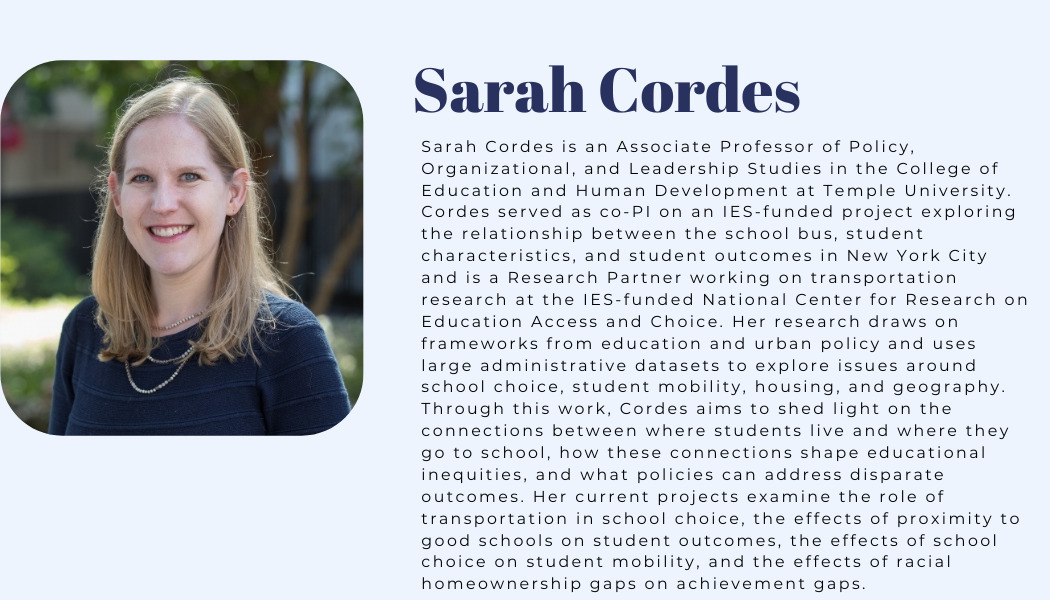
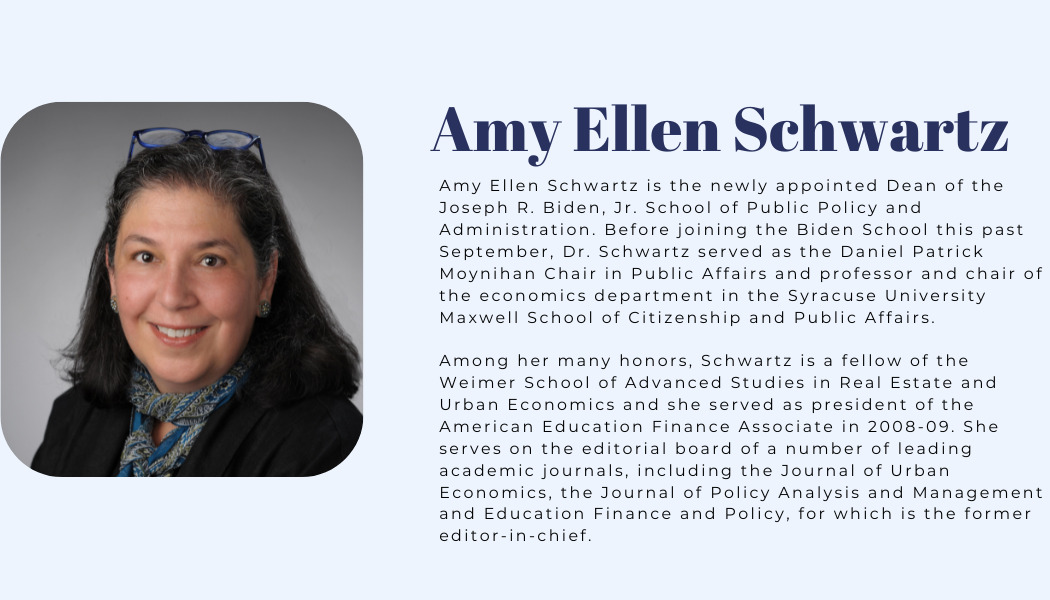
Decades of research documents unequal access to high quality schools, driven both by historic patterns of housing segregation and school siting decisions. Therefore, the idea of school choice, which decouples residence from school, has broad intuitive appeal. By allowing students to attend public schools other than their residentially assigned school, school choice can enable students from disadvantaged neighborhoods with low quality schools access to higher quality schools in other neighborhoods.
While more affluent families have long exercised choice either through residential location decisions or enrollment in private or parochial schools, public school choice extends this freedom to all families regardless of income. Thus, school choice has the potential to reduce persistent disparities in the quality of schools attended by economically disadvantaged students and their more affluent peers, as well between those attended by students of color and white students.
Realizing these potential benefits of school choice, however, requires three important conditions be met:
- First, higher quality options must be available.
- Second, students must be able to get to these schools.
- Finally, any benefit from attending these schools must outweigh additional travel costs that students experience from attending a school located farther from home then their neighborhood school.
Therefore, pupil transportation is a key lever for the success of school choice.
What does pupil transportation look like?
Despite the ubiquity of the yellow school bus and its dominance as the primary district-provided mode of transportation, pupil transportation can (and does) come in many forms. Many urban districts with robust public transportation infrastructure, such as New York City, Baltimore, and Washington, D.C. offer students free transit passes that can be used on public buses or the subway. In the wake of recent school bus shortages, some districts such as Philadelphia and Chicago are offering parents financial reimbursement if they opt out of the school bus. These reimbursements can be used to help offset the costs of gas or private rideshares.
Why and how does transportation matter for school choice?
Whatever form it takes, the research on the importance of transportation promoting educational equity and access is clear. Access to a personal car plays an important role in shaping families’ choice options (Valant & Lincove, 2023; Lenhoff et al., 2023) and parents report that transportation (or lack thereof) poses a problem for school choice (Teske et al., 2009; Jochim, 2014).
Evidence from New York City finds that students who are eligible for and use pupil transportation are more likely to attend a school other than their neighborhood school and are significantly more likely to attend a higher quality school. These relationships are largest for Black and Hispanic students, indicating that pupil transportation, especially the school bus, is an important lever for promoting equitable access to choice schools (Cordes & Schwartz, 2019). Likewise, students are more likely to choose schools that offer the school bus, and bus eligibility increases the likelihood that students attend a school further from home (Trajkovski et al, 2021).
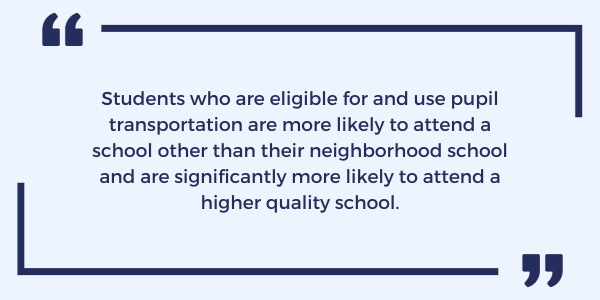
In addition to facilitating enrollment in choice schools, transportation also plays an important role in ensuring that students actually attend school–particularly for Black, Hispanic, and economically disadvantaged students (Cordes et al, 2019; Edwards, 2023) Students who use the school bus have higher attendance and lower chronic absenteeism (Gottfried, 2017; Gottfried & Kirksey, 2021; Cordes et al, 2019; Edwards 2023), which is particularly important as the pandemic has spurred unprecedented rates of chronic absenteeism. .
Transportation also has an important role to play in students staying enrolled at their school of choice. For example, students in Baltimore with more difficult commutes were more likely to transfer during ninth grade than students with less difficult commutes. In addition, these students tended to transfer to schools that were not among their top five choices during the high school selection process (Stein et al, 2021).
What do district transportation policies look like?
Despite the growing evidence that transportation matters, states and districts vary widely in the extent to which subsidized transportation is available to students who attend choice schools and how transportation services are coordinated.
For example, in Louisiana, districts are required to provide transportation to students living more than one mile from school. The implication of this policy in New Orleans, which has a city-wide system of charter schools that are each considered their own local education agency, is that each school is responsible for providing and paying for transportation, which is primarily in the form of a yellow school bus.
Detroit, which has limited public transportation, provides transportation for students attending district public schools, while transportation for public charter school students or students attending a neighboring district is at the discretion of the charter school or district. In New York City, transportation for traditional public and charter schools is coordinated centrally in the Office of Pupil Transportation. All K-5 students who live far enough from school (traditional, public, or charter) are eligible for free transportation in the form of either a school bus or MetroCard, but the decision of whether or not to offer the bus is left to the discretion of individual principals. Once students reach sixth grade, the primary mode of free transportation is MetroCards. Costs for transportation are covered by the New York City Department of Education, which receives transportation aid from the state.
This mixture of policies reflects two important realities of pupil transportation: it is expensive and it is difficult to coordinate. On average, districts spend about $600 per pupil on transportation, which amounts to roughly 4 percent of total education expenditures (Weinstein et al, 2022). When charter schools are left responsible for covering their own transportation costs, this reduces the financial impact on the state or districts but has serious consequences for the schools that must ultimately contend with financial tradeoffs (Satin-Bajaj, 2023).
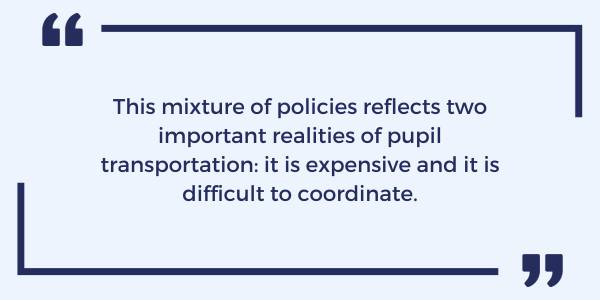
Coordination and logistics also pose a challenge, as designing efficient bus routes is a complex process, and efficient bus routes do not necessarily translate to equitable ones. Even if districts decide to favor equitable bus routes over efficient ones, this requires a clear definition of “equity” and discussion of what groups should be prioritized for shorter routes or even being included on bus routes.
Offering passes for public transit also poses logistical hurdles, as it requires obtaining transit passes and tracking which students receive these passes. Centralizing these logistics, as in NYC, likely increases efficiency, but at the same time requires some level of cooperation between the traditional public and charter sectors.
How can states and districts promote more equitable transportation policies?
In an ideal world, all schools would be required to offer transportation to their students, which would be coordinated centrally by the district (to promote efficiency) and funded by the state (to promote equity). The reality is more complicated, as states and districts must balance costs and benefits of increased transportation access.
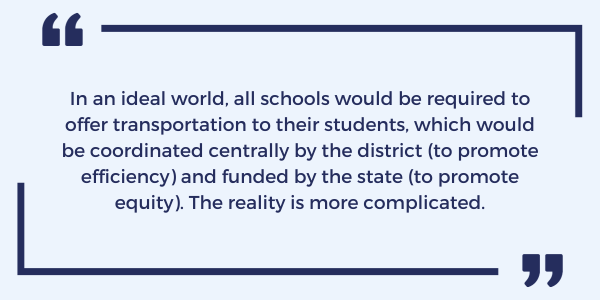
One option would be to stagger start-times across schools, which could allow the same buses to be used at multiple schools. Districts could also allow the same bus to serve multiple schools with the same start time, although this would likely increase the length of bus rides and could raise safety concerns if there are intense school rivalries at play. In cases where schools have multiple shorter routes, districts might consider combining these to free up capacity for students living further away from school.
In addition to more “traditional” forms of transportation like the yellow school bus and transit passes (where appropriate), districts can consider other alternatives. For example, school bus loops, like Denver’s “Success Express,” serve multiple schools and allow students multiple pick-up and drop-off times at each stop along the designated route. Districts can also offer financial reimbursements to families who drive or carpool to school, or they can arrange additional supports to students who may be traveling from the same neighborhoods such as a “buddy system,” escorts, or adults stationed along common routes.
Districts might also reconsider their “walk zone” to include considerations other than distance in determining eligibility for pupil transportation, such as crime and safety, or whether students live in transportation deserts. Of course, any decisions regarding transportation policies should carefully consider the district context including the availability and feasibility of public transportation and where schools are located relative to where they draw their enrollments.
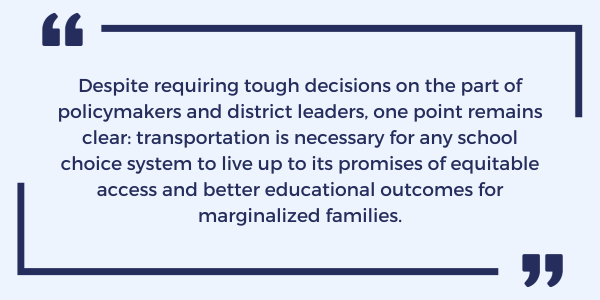
Despite requiring tough decisions on the part of policymakers and district leaders, one point remains clear: transportation is necessary for any school choice system to live up to its promises of equitable access and better educational outcomes for marginalized families.